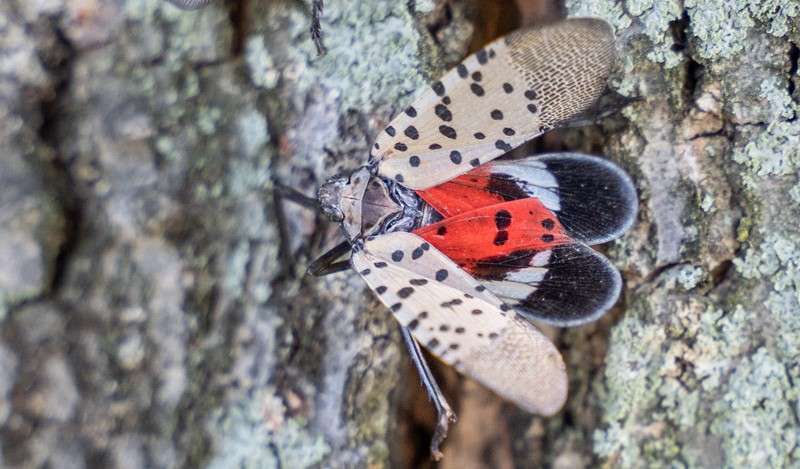SCORES & OUTDOORS: Have you seen this invasive plant hopper?
 by Roland D. Hallee
by Roland D. Hallee
Have you seen one of these?
The spotted lanternfly, Lycorma delicatula, is an invasive planthopper that feeds on a wide range of plants, including grapes, hops, stone fruits, and hardwood trees. When the spotted lanternfly feeds, it excretes a sticky, sugary fluid that causes sooty mold, which can further damage plants. Its preferred host is tree of heaven. Today 17 states have some degree of infestation.
The spotted lanternfly is a hitchhiking pest that is native to Asia. It lays its eggs on any hard surface including grills, vehicles, trailers, firewood, outdoor furniture, bikes and toys. The pest was first detected in 2014 in Pennsylvania. It likely arrived in the United States on goods shipped from overseas.
The spotted lanternfly can harm our fruit and forest industries. Early detection is a critical step to mitigating economic and ecological losses. Residents in SLF quarantine areas should check outdoor items before traveling to new areas. Here’s what to look for:
Nymphs (juvenile spotted lanternflies) are black with white spots and turn red as they develop.
Adults, roughly one-inch long and 1/2-inch wide, have a yellow, black-barred abdomen. With large, visually striking wings, adult spotted lanternflies can be easier to spot than other pests. They have brown forewings with black spots at the front and a speckled band at the rear. Their hind wings are scarlet with black spots at the front and white and black bars at the rear.
Newly laid egg masses (holding 30-50 eggs) resemble wet, gray putty before turning dull and brown, mirroring a smear of cracked mud. The one-inch long egg masses can be seen in fall, winter, and spring on a variety of smooth surfaces, such as trees, bricks, stones, fences, grills, equipment, and vehicles.
When spotted lanternflies feed on plants, they leave behind a sticky, oozing residue called honeydew. This substance attracts other insects, causes mold growth, and further hurts plants.
As honeydew ferments, it can develop an intense, rotten smell.
One of the best places to look for these pests is on a tree-of-heaven, a favorite plant for spotted lanternflies. The tree has a cantaloupe-like texture, with bark that appears light brown to gray. The leaves are large, one to four feet in length. These leaves are made up of many smaller leaflets on both sides of a central stem.
Spotted lanternflies (both nymphs and adults) frequently gather in large numbers when feeding. They’re easiest to spot at dusk or at night as they migrate up and down the trunk of a plant. During the day, they tend to cluster near the base or canopy of a plant, making them more difficult to see.
While there is no active infestation of the spotted lanternfly in Maine, spotted lanternfly eggs were discovered in the Pine Tree State in 2020. Spotted lanternfly has also been seen in neighboring New Hampshire.
Not sure if you’ve seen a spotted lantern fly? If you think you see any of the life stages of the spotted lanternfly, please report it to Bugwatch@maine.gov.
Roland’s trivia question of the week:
In the 1971 Olympics, Nadia Comaneci was the first gymnast to record a perfect score. What country was she representing?
Responsible journalism is hard work!
It is also expensive!
If you enjoy reading The Town Line and the good news we bring you each week, would you consider a donation to help us continue the work we’re doing?
The Town Line is a 501(c)(3) nonprofit private foundation, and all donations are tax deductible under the Internal Revenue Service code.
To help, please visit our online donation page or mail a check payable to The Town Line, PO Box 89, South China, ME 04358. Your contribution is appreciated!



I love The Town Line. It keeps getting better and better.
I want to add a bit of information to Roland Hallee’s article on spotted lanternfly. He mentioned that this lanternfly may be found on tree-of-heaven plants. Not being familiar with that name of the plant, I searched for it online. I found that it is itself a highly invasive plant (Ailanthus altissima). It looks similar to native black walnut and staghorn sumac. The Ailanthus altissima is capable of poisoning other plants near it and is seriously invasive. Once identified, it so should be removed.